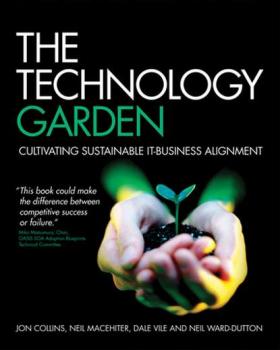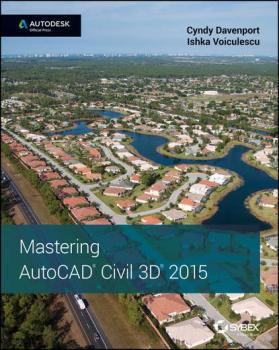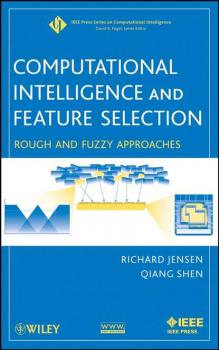ТОП просматриваемых книг сайта:















Зарубежная компьютерная литература
Различные книги в жанре Зарубежная компьютерная литература, доступные для чтения и скачиванияАннотация
The book contains a practical approach and real actions that can transform the credibility and alignment of IT to the business. –Myron Hrycyk, CIO, NYK Logistics UK & Eire «A significant addition to the Enterprise Architect's bookshelf.» –Rupert Brown, Principal Architect, Merrill Lynch Global Business Technology EMEA Many IT deployments fall short of delivering value to the businesses that pay for them. On top of this, the combined forces of rapid business change and technology innovation frequently outpace the ability of IT organisations to make sense of their implications. With business activity and IT now so intimately intertwined, organizations urgently need a framework which allows them to align IT capabilities with business strategies and priorities in a way that is sustainable. A team of IT-expert authors with more than 80 years' combined experience have interviewed dozens of CIOs, IT directors and other senior technical and business decision makes to find out what works and what doesn't. The result is a handbook for organizations of all sizes that want to improve the value of their IT investments, thus enabling their IT capabilities to play a more pivotal business role. Written in plain English that does not descend into technical detail, The Technology Garden provides practical advice for organizations looking to achieve sustainable IT-business alignment. To do so, it defines: * Six key principles – a distillation of best practice that readers can apply directly to the domain of IT-business alignment * A framework for their application – a pragmatic roadmap for the application of the principles * Adoption guidelines – a set of self-assessment checklists that readers can use to understand where they are on the IT-business alignment roadmap and how to progress. With groundbreaking research and proven approaches, this blueprint enables readers to understand what is at the heart of IT-business alignment. Combining IT research, analysis and real-world insight, The Technology Garden is the ultimate no-nonsense guide.
Аннотация
A fan of the SolidWorks Bible, but want more detail on assemblies? Here you go. SolidWorks fans have long sought more detail on SolidWorks topics, and now you have it. We took our popular SolidWorks Bible, divided it into two books (SolidWorks 2011 Assemblies Bible and SolidWorks 2011 Parts Bible) and packed each new book with a host of items from your wish lists, such as more extensive coverage of the basics, additional tutorials, and expanded coverage of topics largely ignored by other books. This SolidWorks 2011 Assemblies Bible shows you how to organize parts data to create assemblies or subassemblies using the latest version of the 3D solid modeling program, SolidWorks Thoroughly describes best practices and beginning-to-advanced techniques using both video and text Explains and thoroughly covers every assembly function and is written in a way that enables the reader to make better decisions while using the software Written by well-known and well-respected SolidWorks guru Matt Lombard Can stand alone or also with the SolidWorks 2011 Parts Bible for a complete SolidWorks reference set Keep both the SolidWorks 2011 Assemblies Bible and the SolidWorks 2011 Parts Bible on your desk, and you?ll have the best resource set out there on SolidWorks.
Аннотация
The first comparative examination of planning paradigms This text begins with the principle that the ability to anticipate and plan is an essential feature of intelligent systems, whether human or machine. It further assumes that better planning results in greater achievements. With these principles as a foundation, Planning in Intelligent Systems provides readers with the tools needed to better understand the process of planning and to become better planners themselves. The text is divided into two parts: * Part One, «Theoretical,» discusses the predominant schools of thought in planning: psychology and cognitive science, organizational science, computer science, mathematics, artificial intelligence, and systems theory. In particular, the book examines commonalities and differences among the goals, methods, and techniques of these various approaches to planning. The result is a better understanding of the process of planning through the cross-fertilization of ideas. Each chapter contains a short introduction that sets forth the interrelationships of that chapter to the main ideas featured in the other chapters. * Part Two, «Practical,» features six chapters that center on a case study of The Netherlands Railways. Readers learn to apply theory to a real-world situation and discoverhow expanding their repertoire of planning methods can help solve seemingly intractable problems. All chapters have been contributed by leading experts in the various schools of planning and carefully edited to ensure a consistent high standard throughout. This book is designed to not only expand the range of planning tools used, but also to enable readers to use them more effectively. It challenges readers to look at new approaches and learn from new schools of thought. Planning in Intelligent Systems delivers effective planning approaches for researchers, professors, students, and practitioners in artificial intelligence, computer science, cognitive psychology, and mathematics, as well as industry planners and managers.
Аннотация
Combining biology, computer science, mathematics, and statistics, the field of bioinformatics has become a hot new discipline with profound impacts on all aspects of biology and industrial application. Now, Computational Intelligence in Bioinformatics offers an introduction to the topic, covering the most relevant and popular CI methods, while also encouraging the implementation of these methods to readers' research.
Аннотация
The main purpose of this book is to investigate, explore and describe approaches and methods to facilitate data understanding through analytics solutions based on its principles, concepts and applications. But analyzing data is also about involving the use of software. For this, and in order to cover some aspect of data analytics, this book uses software (Excel, SPSS, Python, etc) which can help readers to better understand the analytics process in simple terms and supporting useful methods in its application.
Аннотация
An analytical overview of the state of the art, open problems, and future trends in heterogeneous parallel and distributed computing This book provides an overview of the ongoing academic research, development, and uses of heterogeneous parallel and distributed computing in the context of scientific computing. Presenting the state of the art in this challenging and rapidly evolving area, the book is organized in five distinct parts: Heterogeneous Platforms: Taxonomy, Typical Uses, and Programming Issues Performance Models of Heterogeneous Platforms and Design of¿Heterogeneous Algorithms Performance: Implementation and Software Applications Future Trends High Performance Heterogeneous Computing is a valuable¿reference for researchers and practitioners in the area of high performance heterogeneous computing. It also serves as an excellent supplemental text for graduate and postgraduate courses in related areas.
Аннотация
The most complete resource for learning AutoCAD Civil 3D Mastering AutoCAD Civil 3D is the ultimate guide to the new standard in civil engineering software. With combined experience in both civil engineering and Autodesk Civil 3D, authors Cyndy Davenport and Ishka Voiculescu guide you through the ins and outs of the program, from the fundamentals to the little-known tricks that make a big difference. The book focuses on real-world applications in professional environments, and presents topics and ideas not found anywhere else. Lessons begin simply, with an overview of the software and interface, and then gradually progress to more complex topics. AutoCAD Civil 3D is the standard software for civil engineering and design. From surveying and mapping, to design, to documentation and analysis, the program offers expanded capabilities and complementary workflows, allowing easy integration with InfraWorks, Revit Structure, and more. The ability to complete a project within a single suite means increased productivity and continuity, which translates into quicker turnaround, better-designed structures, and streamlined project management. The savvy civil engineering professional must be well versed in the program's full functionality as it expands throughout government agencies and private companies. This book features in-depth coverage of topics including: Surveying, points, and alignments Profiles, corridors, and grading LandXML and LDT project transfer Visualization, sheets, and project management The book also features downloadable datasets that enable you to access the lessons most relevant to your needs, and includes an objectives map to help you prepare for the Civil 3D certification exam. For the civil engineering professional hoping to remain relevant in a changing industry, Mastering AutoCAD Civil 3D is the ultimate resource.
Аннотация
The perfect reference for all AutoCAD users AutoCAD 2015 and AutoCAD LT 2015 Bible is the book you want to have close at hand to answer those day-to-day questions about this industry-leading software. Author and Autodesk University instructor Ellen Finkelstein guides readers through AutoCAD 2015 and AutoCAD LT 2015 with clear, easy-to-understand instruction and hands-on tutorials that allow even total beginners to create a design on their very first day. Although simple and fundamental enough to be used by those new to CAD, the book is so comprehensive that even Autodesk power users will want to keep a copy on their desks. Here is what you'll find inside the book: Part I: Introducing AutoCAD and AutoCAD LT Basics Part II: Drawing in Two Dimensions Part III: Working with Data Part IV: Drawing in Three Dimensions Part V: Organizing and Managing Drawings Part VI: Customizing AutoCAD and AutoCAD LT Part VII: Programming AutoCAD Part VIII: Appendixes Appendix A: Installing and Configuring AutoCAD and AutoCAD LT Appendix B: AutoCAD and AutoCAD LT Resources In addition, the book also explores advanced techniques like programming with AutoLISP and VBA, and demonstrates AutoCAD 2015 customization that can smooth workflow. The companion website contains real-world drawings for each tutorial, plus bonus chapters and video tutorials. If you need to become an AutoCAD guru, AutoCAD 2015 and AutoCAD LT 2015 Bible is the one resource that will get you there quickly.
Аннотация
The expert content in Mastering Autodesk® Inventor 2009 and Autodesk InventorLT 2009 will help you learn advanced related to the industry-leading 3D mechanical design software. Coverage of subjects like design tactics for large assemblies, effective model design for different industries, strategies for effective data and asset sharing across teams, using 2D and 3D data from other CAD systems, and improving designs is through and comprehensive. With straightforward explanations, real-world examples, practical tutorials, tips, tricks, and techniques, this book will be your go-to guide to Autodesk Inventor.
Аннотация
The rough and fuzzy set approaches presented here open up many new frontiers for continued research and development Computational Intelligence and Feature Selection provides readers with the background and fundamental ideas behind Feature Selection (FS), with an emphasis on techniques based on rough and fuzzy sets. For readers who are less familiar with the subject, the book begins with an introduction to fuzzy set theory and fuzzy-rough set theory. Building on this foundation, the book provides: A critical review of FS methods, with particular emphasis on their current limitations Program files implementing major algorithms, together with the necessary instructions and datasets, available on a related Web site Coverage of the background and fundamental ideas behind FS A systematic presentation of the leading methods reviewed in a consistent algorithmic framework Real-world applications with worked examples that illustrate the power and efficacy of the FS approaches covered An investigation of the associated areas of FS, including rule induction and clustering methods using hybridizations of fuzzy and rough set theories Computational Intelligence and Feature Selection is an ideal resource for advanced undergraduates, postgraduates, researchers, and professional engineers. However, its straightforward presentation of the underlying concepts makes the book meaningful to specialists and nonspecialists alike.










